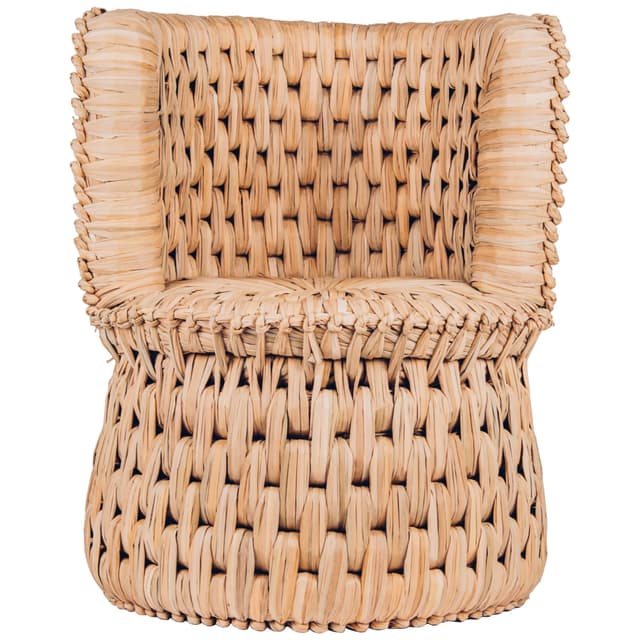Colin Nagy | October 28, 2019
Why is this interesting? - The Tule Edition
On artisans, furniture, and second acts
Recommended Products

Intricately woven furniture based on pre-Hispanic techniques, part of Txt.ure's initial collection.

Rugs created with a traditional Turkish Knot technique, a result of intense research and collaboration with Casa Luis Barragán.
Colin here. I recently wrote on the craft of bespoke tailoring in last Thursday’s WITI. It is something that, without new generations of interest, could conceivably die out. I also wrote in Courier Magazine (appearing only in print) about a Mexican project preserving design history from extinction:
A project called Txt.ure in Mexico City is helping aging male members of the population create their next act, after they’ve finished the first phase of their career. The initial run of products are intricately woven furniture based on pre-Hispanic techniques. These methods were in danger of dying out, as the artisans and makers were getting old and disinterested in continuing. The founder realized that two or three families, based about an hour outside of Mexico City, held all of the knowledge of the craft and it was about to go away.
After raising funds through small private investments and on Kickstarter, the project started with an initial collection of woven furniture, which found favor with the international design set, being prominently featured at Liz Lambert’s Hotel San Cristobal in Todos Santos, among other residential and commercial projects around the world.
While others pay heavy lip service to social good to drive a press narrative, the ethics of the idea were embedded into the business from the start. The artisans are actual partners and essential to every element of the design and creation.
The chairs in the collection, called tule, require rigorous physical manipulation and elbow grease. Most of the trained artisans making the chairs are men, who need to be super strong (given the tightly woven design) and work in semi-uncomfortable positions for a length of time.
Why is this interesting?
The project founder realized it was also offering something interesting to the community: the ability for these men to make a creative pivot after their first career, while helping preserve artistic heritage.
One example is Don Cornelio, who learned how to weave as a young man, alongside all of the other men in his town. After a long career as a hairdresser in his village, and taking care of his mother, he returned to the craft in partnership with Txt.ure.
“Through the work that we do together, I believe Don Cornelio is integrated into a social network that visits him every week. He has chores to do, like getting the palm, storing it, and doing the weaving, besides the gardening that he loves to do to keep his beautiful floral garden alive. He is active, healthy and very committed to the craft and to the work we do together,” says Txt.ure’s founder.
The lead artisan, Don Nacho, has been able to build a workshop, buy a car, provide for his family, and also moved his eldest son into the business. The duo are now producing 75 percent of the pieces for Txt.ure which is growing in demand from the design community globally.
Both men, neighbors for over two decades, have found a second act, more economic mobility, and the ability to contribute to keeping a weaving technique around.
The resulting projects have a very interesting aesthetic: They seem oddly futuristic and otherworldly. Through lost fragments and narratives of Mexican design history, filtered by a modern, crowdfunded, and socially astute business model, the result seems like a combination of a storied past with the technology and knowledge of the present. (CJN)
Recommendation of the day:
The same project is now making rugs. “After one year of intense research, plus another year collaborating with Casa Luis Barragán —located in the neighborhood of Tacubaya in Mexico City— txt.ure team has recovered an extinct technique. This traditional Turkish Knot technique is the result of several time consuming processes that make it a luxurious design-craft piece to own.” The pieces are extraordinary and worth checking out. (CJN)

Quick Links:
Couldn’t fit this in Friday’s Watchmen edition. From Emily Nussbaum’s Fargo Season 1 review: “How good does a violent drama need to be to make the pain of watching worth it? ‘Breaking Bad,’ thumbs up; the brilliantly nightmarish ‘Hannibal,’ too. Other shows—’The Walking Dead,’ say—have seemed like a bad bet. As the critic James Poniewozik tweeted recently, ‘TV’s not a chili-pepper-eating contest.’” (NRB)
How a Band of Surfer Dudes Pulled Off the Biggest Jewel Heist in N.Y. History (NRB)
Thanks for reading,
Noah (NRB) & Colin (CJN)
Why is this interesting? is a daily email from Noah Brier & Colin Nagy (and friends!) about interesting things. If you’ve enjoyed this edition, please consider forwarding it to a friend. If you’re reading it for the first time, consider subscribing (it’s free!).